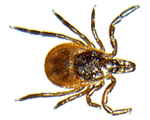| |
|
Lyme Disease and Deer Removal Services
 | |
Deer Removal: Deer are tricky to control. They chew up your plants and landscaping, and they can spread Deer Ticks and Lyme Disease. But they can't be trapped and removed. You can spray
a sulphur (rotten egg smelling) substance, a deer repellent, on your plants. Or you can get motion-sensitive water sprayers to scare them away. Or you can shoot a gun or pyrotechnics at them every time you see them, which discourages them
from coming to your property. |
 |
Ticks: Are notorious parasites, and found on just about any mammal. They are most well known as carriers of Lyme Disease, which is caused by the
Borreliaburgdorferi bacteria and is transmitted by several species of ticks and fleas. The symptoms generally progress through “flu-like” symptoms such as fatigue, fever, sore throat, nausea and coughing.
For more information on this disease, visit Lyme Disease Review. |
Lyme disease is often referred to as Lyme Borreliosis, and is one of the most common diseases that is usually transmitted by ticks. Although it is not generally considered to be a fatal disease, it is important that it is treated otherwise it can cause some conditions that will eventually become life threatening. The disease itself is named after a town in Connecticut where a number of cases were discovered in a short period of time in 1975.
How Is It Transmitted?
The vast majority of reported cases of Lyme disease have been found in people who have been or are believed to have been bitten by a tick. It is worth noting that not all tick bites will result in Lyme disease, but for those people who have been bitten it is worth keeping the possibility in mind. The disease itself is caused by bacteria falling into the Borrelia family, and the main ones that are actually transmitted to humans come from the ticks that generally attach themselves to deer, particularly the black-legged tick.
Not all of the ticks in the United States actually carry Lyme disease, and many of the central states will find cases of Lyme disease to be very rare. The majority of cases are actually discovered on the east coast, with a particularly high number to be found in the north eastern states and in Minnesota and Wisconsin. The risk on the west coast is fairly low, but there are still a small number of cases reported every year.
The Symptoms
One of the first things that people will notice when the disease starts to develop is a ‘bullseye’ rash around the location of the bite on the body. This will usually appear in the first week after the bite, with an area of white flesh surrounded by a circle of red inflamed flesh. Many sufferers will experience a number of flu-like symptoms, with the bacteria spreading usually within two weeks of the bite. During the first two weeks people may also find that they suffer from sleep disturbance and headaches, and in rare cases may also experience a facial palsy.
What Are The Consequences If It Is Left Untreated?
If Lyme disease is left untreated, then the consequences for the sufferer can be serious. One of the first possible consequences is that the disease can cause arrhythmia and damage the muscle tissues of the heart. It is also known to cause symptoms similar to arthritis in some joints, with the knees being most likely to suffer from the swelling and pain caused by the disease.
Some of the more disturbing consequences of allowing Lyme disease to go untreated can include psychological and behavioral changes. Memory loss, panic attacks and anxiety have all been associated with Lyme disease, and in some cases the psychosis caused by Lyme disease can also be diagnosed as schizophrenia or bipolar disorder.
Diagnosis
There are a number of steps that the doctor will take when they are diagnosing the condition, and one of the first steps will be to look for the distinctive rashes that will appear. The location of the bite will usually have a rash, although not always in the ‘bullseye’ shape, and there may also be a number of other inflamed rashes over the body.
They will also request blood tests to try and confirm the presence of Lyme disease, but this will usually be to try and confirm the diagnosis based on the physical symptoms and rashes. A blood test isn’t usually used as the primary method of diagnosis, as the body will not always produce enough of the required antibodies to become apparent in the test.
Treatment
Early treatment will have a significant impact on whether or not the patient will make a full recovery, and those who have been diagnosed early will usually be given a course of antibiotics to deal with the condition. There have only been limited numbers of studies regarding the treatment of Lyme disease, but there are cases where the condition can survive the use of antibiotic medicines.
Awareness Of The Disease
The number of cases of Lyme disease that have been reported in the United States has been on the increase over recent years. The only state in the country to have never reported a case of Lyme disease is Montana, but those states in the North East is the most common location for cases of Lyme disease.
Because of the potentially severe consequences of allowing Lyme disease to go untreated, the awareness of the condition among physicians has also been increasing. There are also programs in Maine and Connecticut to cull the population of white-tailed deer which is vital to the reproduction of the black-legged tick, and this has been effective. It is also worth noting that people enjoying outdoor pursuits in areas where these ticks are prominent should consider using a DEET based insect repellent, which is shown to reduce the chances of being bitten by a tick.
| |
|